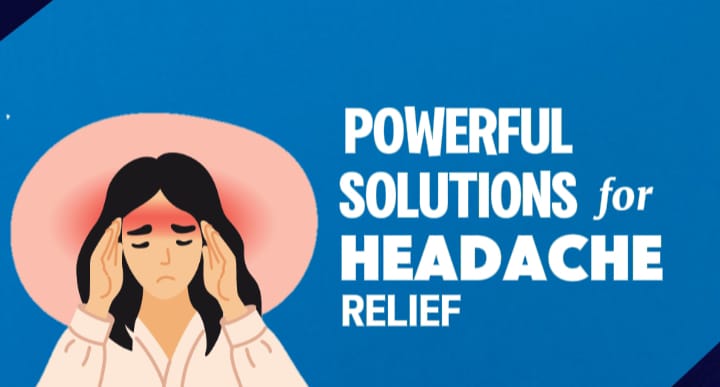
Headaches are a common ailment that many people frequently experience at some point in their lives. They can be caused by a variety of factors, including stress, dehydration, lack of sleep, poor posture, and certain medical conditions. While over-the-counter pain relievers are a popular choice for treating headaches, many individuals prefer to use home remedies for relief. So here are our very own tried and tested home remedies for headache: natural ways to relieve pain.
Understanding Headaches
A headache can be described as a pain or discomfort in the head, scalp, or neck.
It can range from mild to severe and can last from a few minutes to several days. Understanding the different types of headaches and their triggers can help individuals manage their symptoms and find relief.
Some headaches are caused by tension or sinus pressure, while others may be related to migraines or cluster headaches.
Types of Headaches
The following are the types of headaches:
- Tension headaches
- Migraines
- Cluster headaches
- Sinus headaches.
Tension headaches are the most common type and are often described as a dull, aching pain that feels like a tight band around the head.
Migraines is a neurological condition characterized by intense, throbbing pain usually on one side of the head.
Cluster headaches are a rare type of headache that causes intense pain around one eye.
Sinus headaches A sinus headache is caused by inflammation and congestion in the sinus cavities, usually due to a sinus infection (sinusitis) or allergies.
Common Triggers
Headaches can be triggered by a variety of factors, including stress, lack of sleep, dehydration, and certain foods and drinks.
Common triggers include caffeine, alcohol, processed foods, and foods that contain nitrates or MSG. Hormonal changes, such as those that occur during menstruation, can also trigger headaches in some individuals.
To prevent headaches, individuals should try to identify their triggers and avoid them as much as possible.
Maintaining a healthy lifestyle, including getting enough sleep, staying hydrated, and eating a balanced diet, can also help reduce the frequency and severity of headaches.
In summary, headaches are a common health issue that can be managed with proper understanding of their types and triggers.
By identifying triggers and making lifestyle changes, individuals can find relief from headaches and improve their overall quality of life.
Natural Ingredients for Relief

Headaches are a common ailment that can be caused by various factors such as stress, dehydration, and lack of sleep.
While over-the-counter medications can provide relief, natural remedies can also be effective. Here are some natural ingredients that can help alleviate headaches.
Peppermint Oil
Peppermint oil contains menthol, which has a cooling effect that can help reduce pain and inflammation.
Applying a few drops of peppermint oil to the temples and forehead can provide relief from tension headaches.
It is important to dilute the oil with a carrier oil such as coconut or olive oil before applying it to the skin.
Ginger
Ginger has anti-inflammatory properties that can help reduce the pain associated with headaches.
Drinking ginger tea or chewing on a piece of fresh ginger can provide relief from migraines and tension headaches. Ginger can also be added to meals as a spice to reap its benefits.Chamomile Tea
Chamomile tea has been traditionally used for its calming and anti-inflammatory properties, and it may be beneficial for relieving headaches.
Below are some of the potential benefits of chamomile for headaches:
Anti-inflammatory properties: Chamomile contains compounds like flavonoids and terpenoids that have anti-inflammatory effects. Inflammation is a key factor in headaches, and reducing inflammation can help alleviate headache symptoms.
Calming and anxiolytic effects: Chamomile is known for its calming effects, which can help reduce stress and anxiety, common triggers for tension headaches.
Sedative effects: Chamomile has mild sedative properties, which can help improve sleep quality. Poor sleep is often associated with the frequency and severity of headaches.
Drinking chamomile tea can help alleviate tension headaches and migraines. It can also help promote relaxation and improve sleep, which can help prevent headaches.
In conclusion, natural remedies can be effective in alleviating headaches. Peppermint oil, ginger, and chamomile tea are just a few examples of natural ingredients that can provide relief. It is important to note that natural remedies may not work for everyone and that it is important to consult a healthcare professional before trying any new remedies.
Lifestyle Adjustments
Headaches are often caused by lifestyle factors such as dehydration, poor sleep hygiene, and stress. Making simple lifestyle adjustments can help prevent and alleviate headaches.
Hydration
Dehydration is a common cause of headaches. Drinking enough water throughout the day can help prevent headaches from occurring.
It is recommended that individuals drink at least 8 cups of water per day, but this amount may vary depending on factors such as age, sex, and physical activity level.
In addition to water, individuals can also consume other hydrating fluids such as herbal tea or coconut water. It is important to limit or avoid beverages that can dehydrate the body such as alcohol and caffeine.
Sleep Hygiene
Poor sleep hygiene can also contribute to the development of headaches. It is important to establish a regular sleep routine and get enough sleep each night.
Creating a relaxing sleep environment can also help improve sleep quality. This can include using comfortable bedding, keeping the bedroom cool and dark, and avoiding electronic devices before bedtime.
Stress Management
Stress is a common trigger for headaches. Practicing stress management techniques can help prevent and alleviate headaches. Techniques such as deep breathing, meditation, and yoga can help reduce stress levels.
It is also important to identify and avoid stressors when possible. This may include reducing workload, taking breaks throughout the day, and setting aside time for self-care activities.
By making simple lifestyle adjustments such as staying hydrated, practicing good sleep hygiene, and managing stress, individuals can help prevent and alleviate headaches.
For more information on how to manage stress please read our below article:
Preventive Practices
Preventive practices such as regular exercise, maintaining a healthy diet, and avoiding triggers like certain foods or environmental factors can also help reduce the frequency and severity of headaches.
It is important to note that home remedies may not work for everyone and that severe or chronic headaches should be evaluated by a medical professional.
With the right knowledge and approach, home remedies can be a safe and effective way to manage headaches.
Headaches can be prevented by adopting healthy lifestyle habits. This section will discuss some preventive practices that can help reduce the frequency and intensity of headaches.
Regular Exercise
Regular exercise is an effective way to prevent headaches. Exercise helps to reduce stress and tension, which are common triggers of headaches.
It also improves blood circulation and releases endorphins, which are natural painkillers. People who exercise regularly are less likely to suffer from headaches than those who lead a sedentary lifestyle.
Balanced Diet
Eating a balanced diet can also help prevent headaches. A diet that is rich in fruits, vegetables, whole grains, and lean protein can provide the body with the nutrients it needs to function properly.
Skipping meals or eating processed foods can lead to low blood sugar levels, which can trigger headaches. Drinking plenty of water can also help prevent dehydration, which is another common cause of headaches.
Posture Correction
Poor posture can lead to tension headaches. Sitting or standing in the same position for an extended period can cause muscle tension in the neck and shoulders, which can trigger headaches.
Good posture can help prevent tension headaches. People who work at a desk should ensure that their computer screen is at eye level, and their chair is at the correct height.
Conclusion
In conclusion, adopting healthy lifestyle habits such as regular exercise, a balanced diet, and good posture can help prevent headaches. These practices can reduce the frequency and intensity of headaches and improve overall health and wellbeing.
Key Takeaways
- Headaches can be caused by a variety of factors and understanding the cause can help in selecting the right remedy.
- Natural ingredients such as ginger, peppermint, and lavender oil have been used for centuries to treat headaches.
- Lifestyle adjustments and preventive practices can also be effective in preventing headaches.
Reference
Srivastava, J. K., Shankar, E., & Gupta, S. (2010). Chamomile: A herbal medicine of the past with a bright future (Review). Molecular Medicine Reports, 3(6), 895-901. DOI: 10.3892/mmr.2010.377
Amsterdam, J. D., Li, Y., Soeller, I., Rockwell, K., Mao, J. J., & Shults, J. (2009). A randomized, double-blind, placebo-controlled trial of oral Matricaria recutita (chamomile) extract therapy for generalized anxiety disorder. Journal of Clinical Psychopharmacology, 29(4), 378-382. DOI: 10.1097/JCP.0b013e3181ac935c
Zick, S. M., Wright, B. D., Sen, A., & Arnedt, J. T. (2011). Preliminary examination of the efficacy and safety of a standardized chamomile extract for chronic primary insomnia: a randomized placebo-controlled pilot study. BMC Complementary and Alternative Medicine, 11(1), 78. DOI: 10.1186/1472-6882-11-78
https://www.webmd.com/balance/stress-management/stress-management